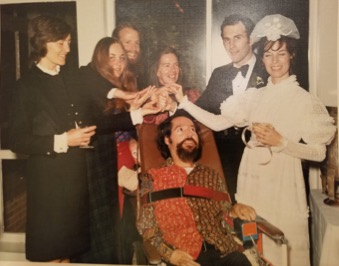Ed Roberts, Activist
Ed as a Kid
An Interview with Ed Roberts' Cousin, Kenneth McManigal, by Lee Roberts
Note from interviewer Lee Roberts, Ed Roberts' son:
LR: So you visited my father, Ed Roberts, as a child?
KM: Yes, probably around when I was 9, 10, 11 and 12 years old. I would say it was around the years of 1947-1951. We would go to Zona and Verne's house (Ed's parents) in the summer. They lived in Burlingame, Calif. (south of San Francisco) across from the Burlingame High School field.
LR: What did you guys do?
KM: Ed used to play a lot with the kids on the street. So did his brother Ron. When we came to visit, we did that, too.
LR: Sports?
KM: Yes, we mainly played baseball. Ed was one of the first guys picked to play, or actually, was usually picked as one of the captains. My brother Jerry and I were always among the last ones picked. I always thought that my brother and I should have been picked earlier (laughs). We played right on the street, and there were always a good amount of players.
Note from Lee: Ken and Jerry actually were incredible athletes, and so are all of their sons and daughters—a couple of them are even Division 1 athletes.

Lee Roberts (center), met with his Jerry McManigal and Kenneth McManigal (Ed's cousins) at Lair of the Bear Camp at University of California, Berkeley to reminisce about Ed Roberts.
LR: So I take it playing baseball was an everyday activity?
KM: We would be out playing before lunch. We'd come home, get a quick lunch, and then immediately go back out. It was a part of life.
LR: And Ed and Ron would visit you, too?
KM: Yes, every summer Ed and Ron would come up and visit us, as well. Although it was mostly Ron, I think, Ed would come sometimes. My mom would take us to the zoo and to play outside in the different parts of the city. It was tough to fit us all [in the house] because at the time, around 1950, we were living in what was like a basement flat in San Francisco, so we were outside a lot.
LR: You had a memory about you and Ed in school?
KM: In 10th grade I had an English teacher named Mrs. Wade. It turned out that Ed had her as well; she was one of the teachers that he took classes from over the phone because he couldn't come to school at the time.
LR: By phone?
KM: Yes, when he got polio, nobody was set up or equipped to accommodate his disability, so they eventually set it up for him to take classes by phone.
LR: So how did you learn he had contracted polio?
KM: I believe my parents told me.
LR: Did you go to see him?
KM: It took a while before I got to see him because everyone was so scared of the disease. Nobody was quite sure about the timing of the virus, and it was even scarier for me because we had already had someone in the family who had gotten a minor case of it a couple years before. My father's brother, Budd, got a minor case of polio. (Budd's real name was Jonas, but he hated his name so we always called him J. Budd McManigal instead.)

Mark Roberts (left) with his big brother Ed
LR: So our family had experience with it?
KM: Yes, but the case was minor. With rest and exercise, Budd was able to fight off what turned out to be a weaker version of the virus. He recovered enough and eventually went into the military.
When Ed got polio, they had to find a different house, because their house had stairs that made it impossible for the iron lung to be put in, and it wasn't accessible enough. They moved a few blocks south, not across from the school anymore. The house that they moved into had, I think only a couple cement steps in the front, and was way more manageable all the way around.
LR: So you actually visited Ed in the hospital?
KM: Yes, we started going to visit.
LR: Do you remember the hospital and Ed's room?
KM: It was [UC Berkeley's] Cowell Hospital. Ed had his own room. It looked like a combination of a dorm room and a hospital room. It always seemed to be clean, and he had his own windows. He had his medical stuff all on one side, with his books, studies, and such on another. Even early on, he had to have an attendant—maybe especially then, because he didn't even have a motorized chair yet. That came later.
LR: Then later, you guys went to the University of California-Berkeley together?
KM: Yes, I arrived in 1956 and I believe Ed came in about 1962 from the College of San Mateo. Along with my brother Jerry and Ed's brother Ron who were '59-'63, I believe. I also was in law school for three years afterwards.

A beautiful and never-before publicly seen photo taken at Ken McManigal's wedding January 15th, 1972, with (left to right): Greta McManigal (Jerry McManigal's wife); an unknown woman; Ron Roberts (Ed's brother); Zona Roberts (Ed's mother); Ed Roberts; Ken McManigal and Victoria Morse McManigal.




